Dijkstra algorithm和Bellman-ford algorithm
Dijkstra algorithm用于算出带权的有向无环图中,从源点到其他节点的开销最小的路径。该算法包含4个步骤:
- 找出开销最低的节点
- 更新该节点的邻居的开销
- 重复1和2步骤,直到对图中的每个节点都遍历到
- 计算最终路径
例如,在下图所示的网络中,源点是u,想要计算出从u到其他节点的开销。

首先,更新源点u的邻居节点x,v, w的开销,得到:

此时,开销最小的节点是x,于是更新x的邻居节点的开销,得到:
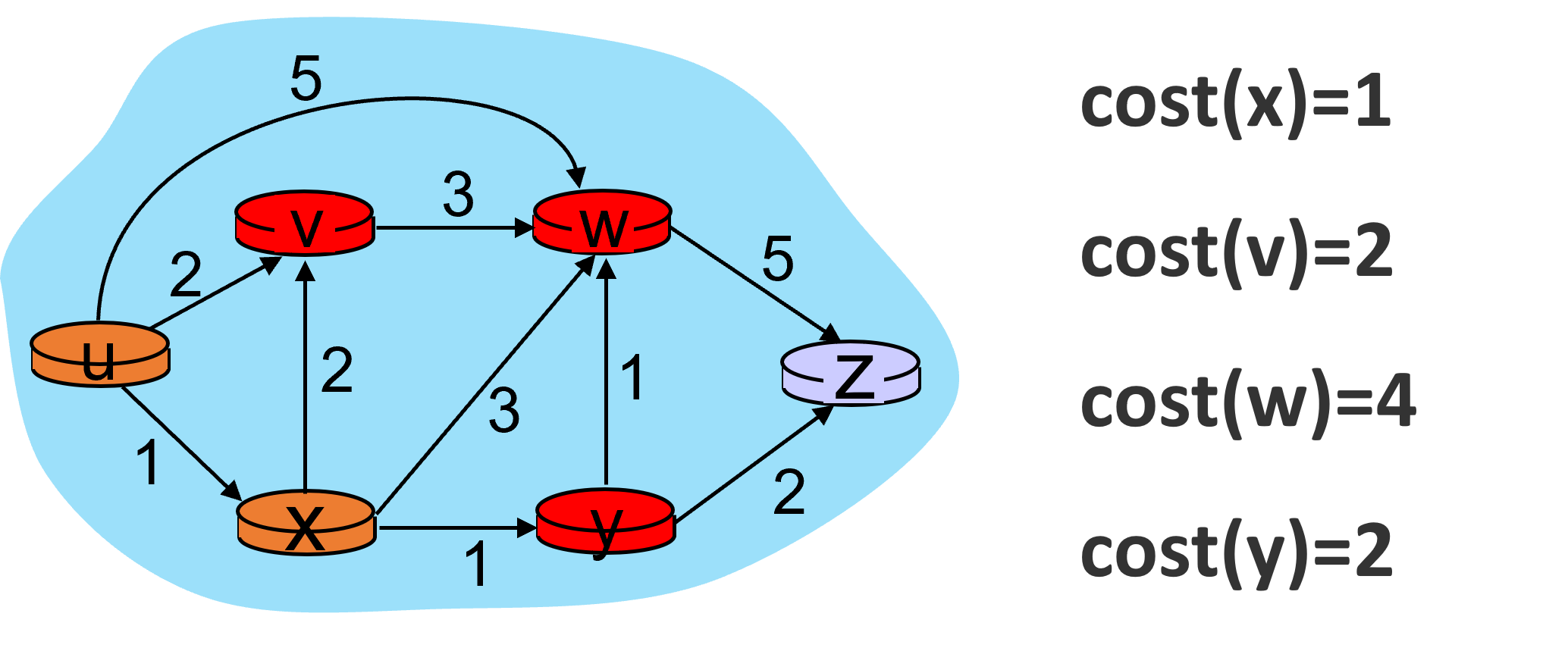
u和x节点已经处理完了,下面更新v的邻居节点的开销,得到:
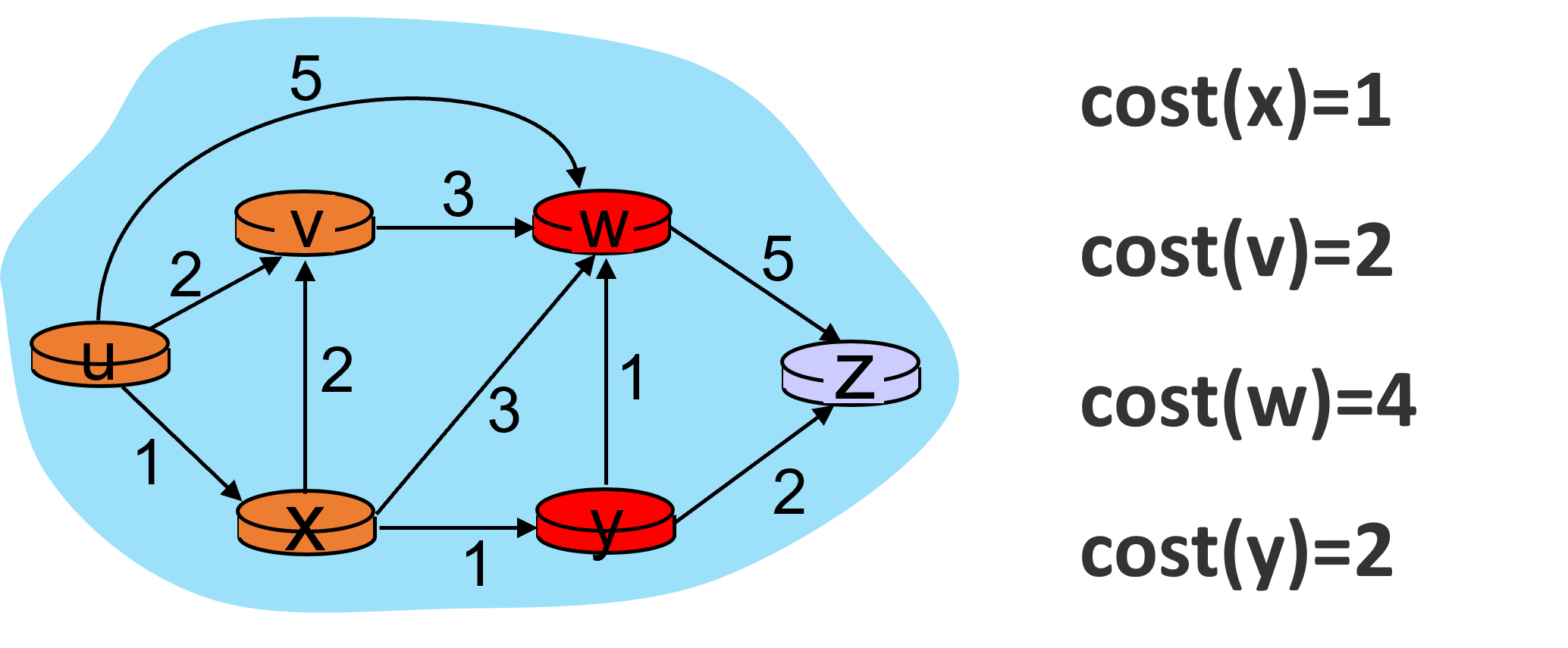
u, x, v节点均已处理完毕,下面更新y的邻居节点的开销,得到:
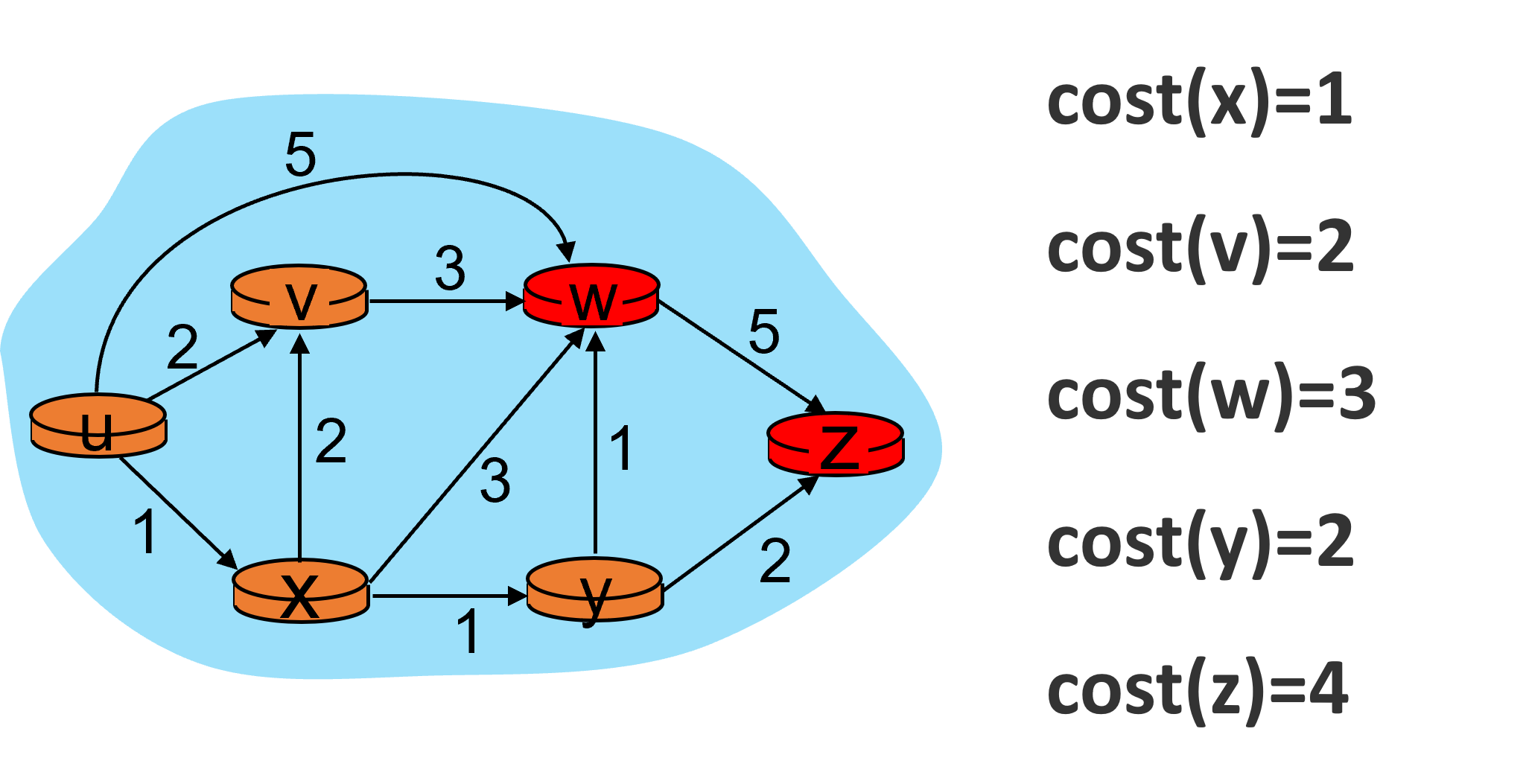
u, x, v, y节点均已处理完毕,下面更新w的邻居节点的开销,得到:
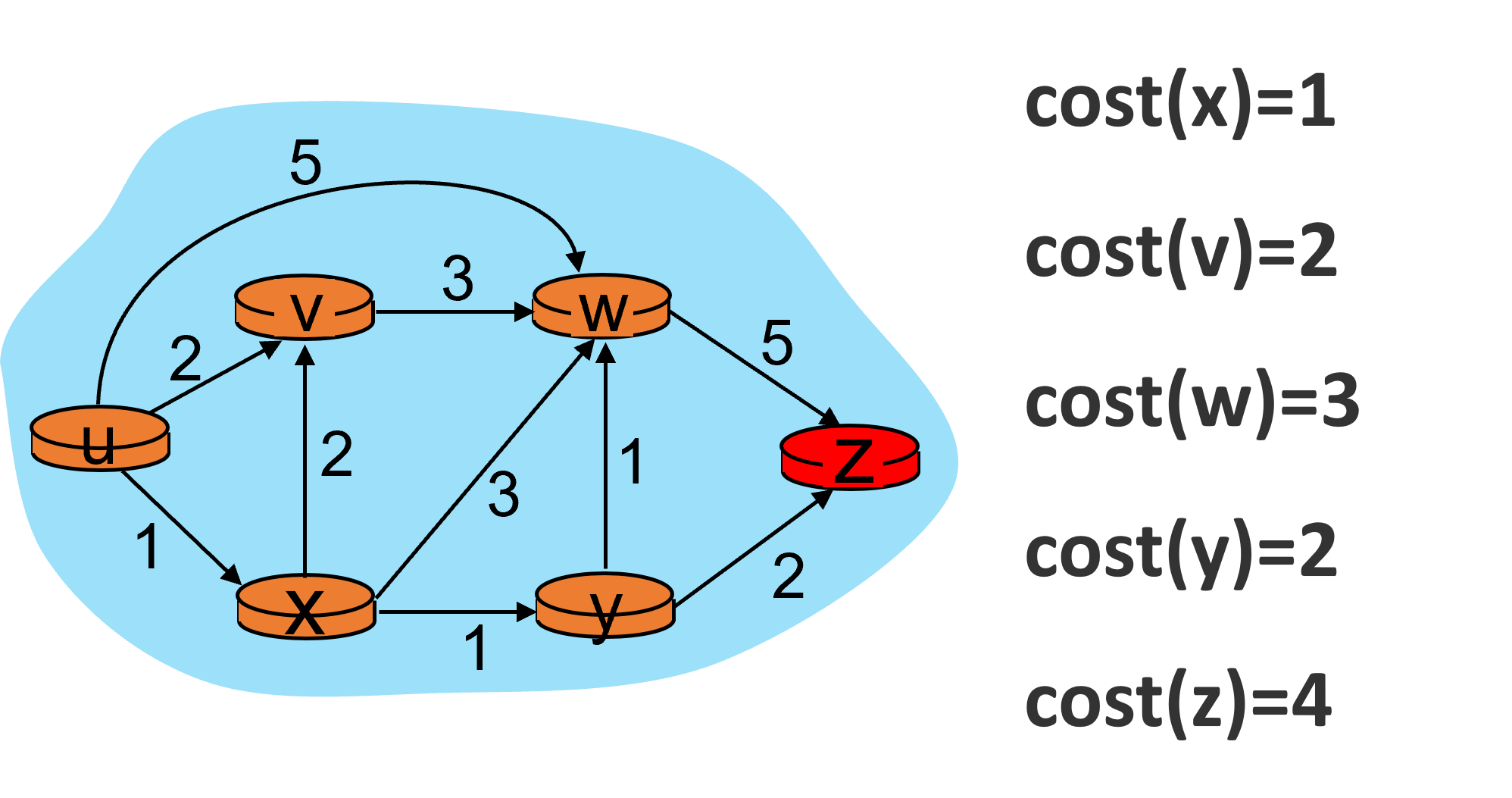
现在只剩下z节点了,它是终止节点,没有邻居节点。至此,所有的节点都已经遍历过了。
参考《算法图解》这本书,用字典表示图。用python实现Dijkstra算法的代码如下:
# 用字典构造图 graph={} infinity=float("inf") # 为了表示出方向和权重,这里使用字典存储节点 graph['u']={} graph['u']['v']=2 graph['u']['x']=1 graph['u']['w']=5 graph['x']={} graph['x']['v']=2 graph['x']['w']=3 graph['x']['y']=1 graph['v']={} graph['v']['w']=3 graph['w']={} graph['w']['z']=5 graph['y']={} graph['y']['w']=1 graph['y']['z']=2 graph['z']={} # 存储从起点到每个节点的开销 # 起点的开销为0 costs={'u':0} # 存储到节点i的最少开销路径的父节点 parents={} # 存储已经处理过的节点 processed=[] # 通过for循环查询当前costs中的最少开销的节点(没有被处理过的) def find_lowest_cost_node(costs): lowest_cost=infinity lowest_cost_node=None for node in costs: cost=costs[node] if cost < lowest_cost and node not in processed: lowest_cost=cost lowest_cost_node=node return lowest_cost_node node=find_lowest_cost_node(costs) while node is not None: cost=costs[node] neighbors=graph[node] for n in neighbors.keys(): new_cost=cost+neighbors[n] if n in costs.keys(): if costs[n] > new_cost: costs[n]=new_cost parents[n]=node else: costs[n]=new_cost parents[n]=node processed.append(node) node=find_lowest_cost_node(costs) print(costs)
Dijkstra算法中每个节点只遍历一次,因此它无法处理有负权边的图。例如在下图中,会先处理v节点,得到cost(v)=2,然后再处理x节点,得到cost(x)=3。v是x的邻居节点,此时会得到cost(v)=1。然而由于v节点已经被遍历过了,所以这时无法接受其开销的更改。
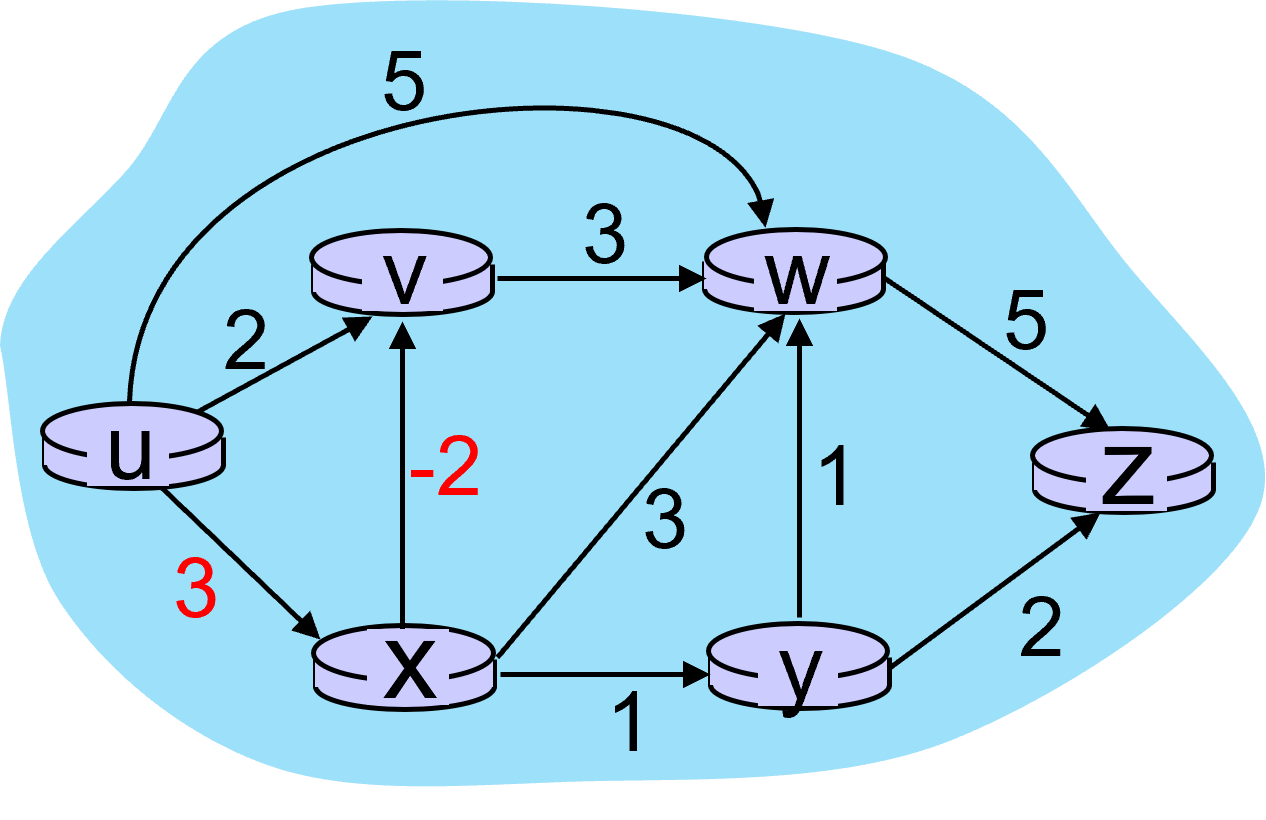
对此情况,可使用Bellman-ford算法。本质就是让v节点能够再被处理一次。
处理u节点
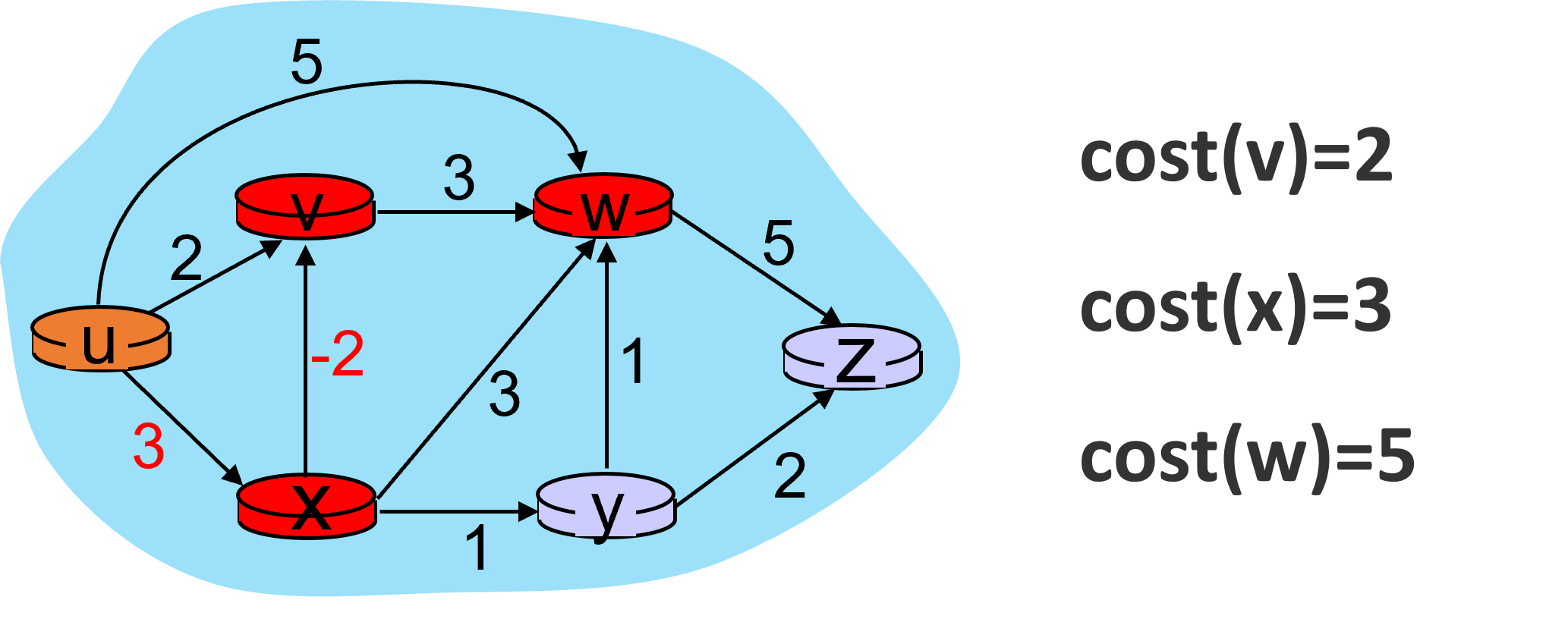
处理v节点,此时不需要优先处理开销最低的节点。
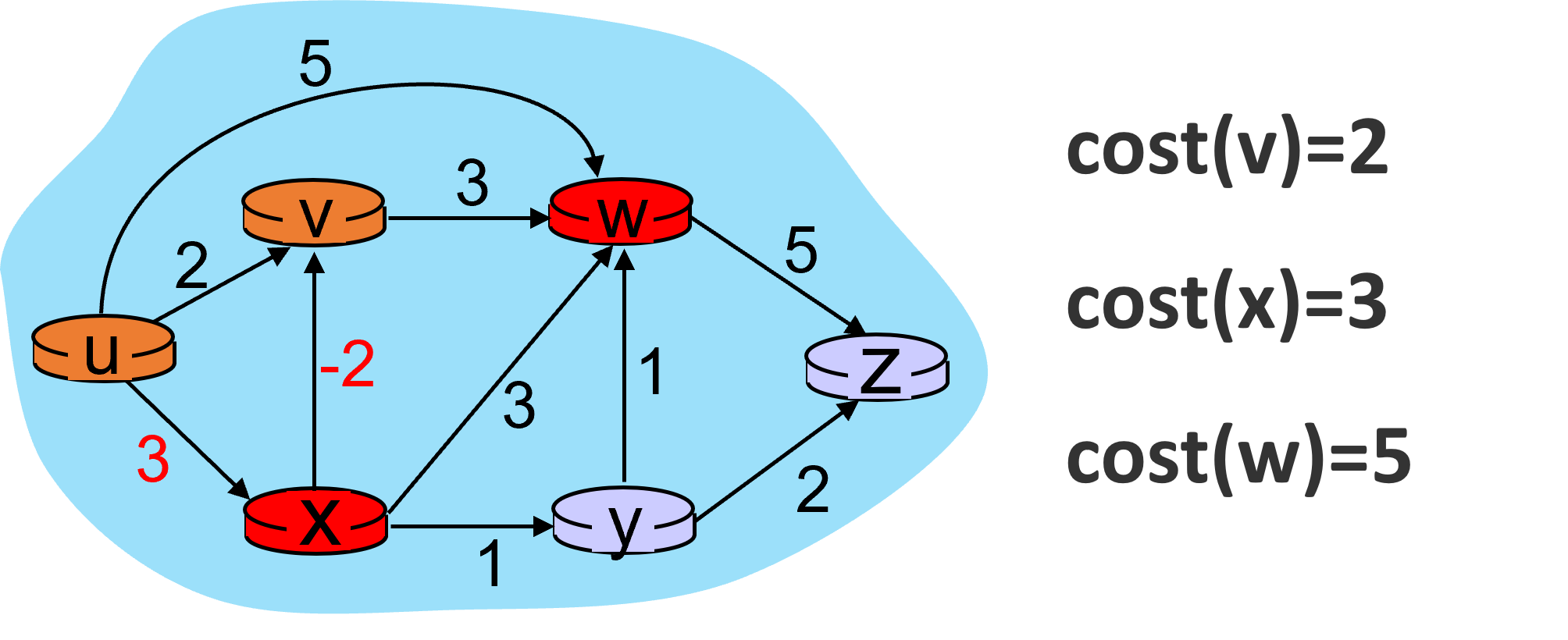
处理x节点,此时v的开销发生了变化。
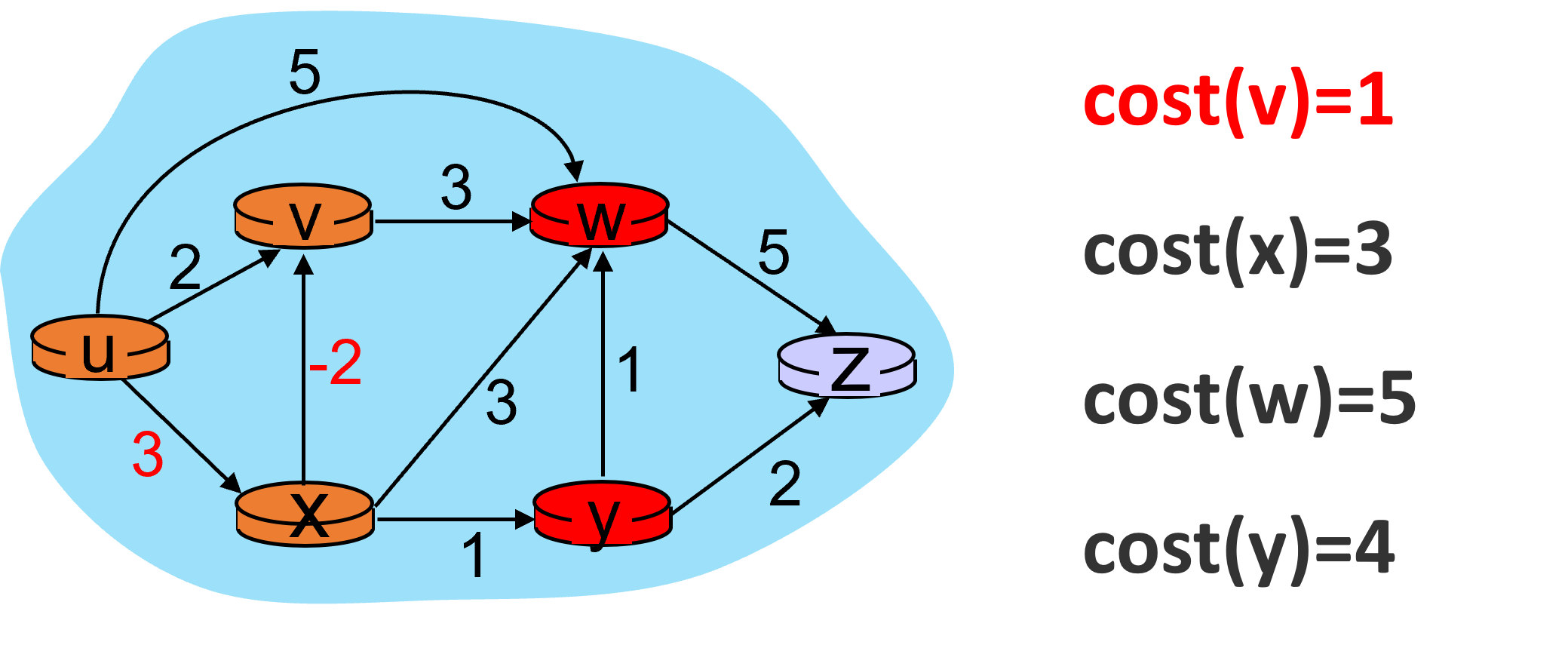
处理w节点
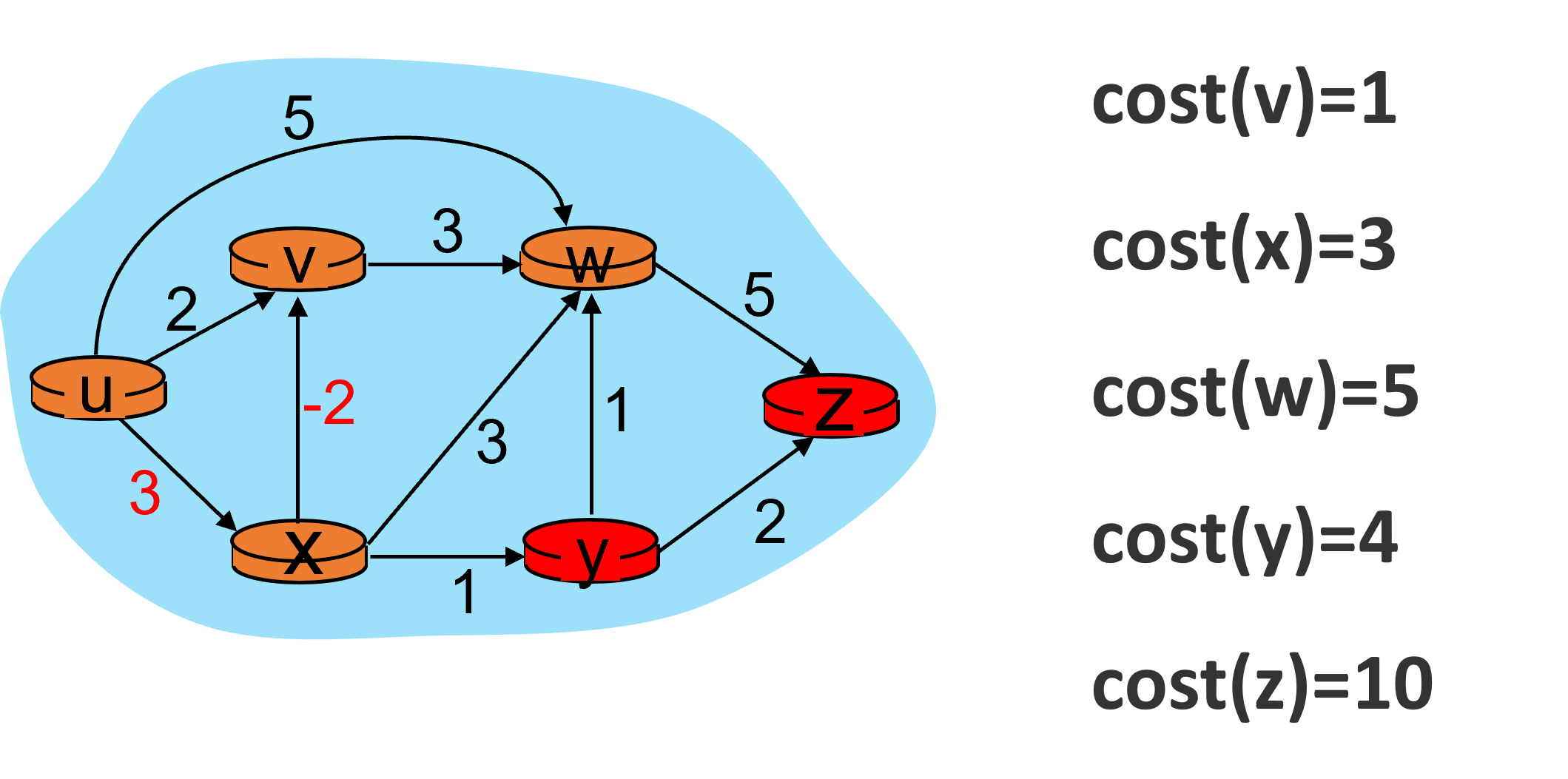
处理y节点
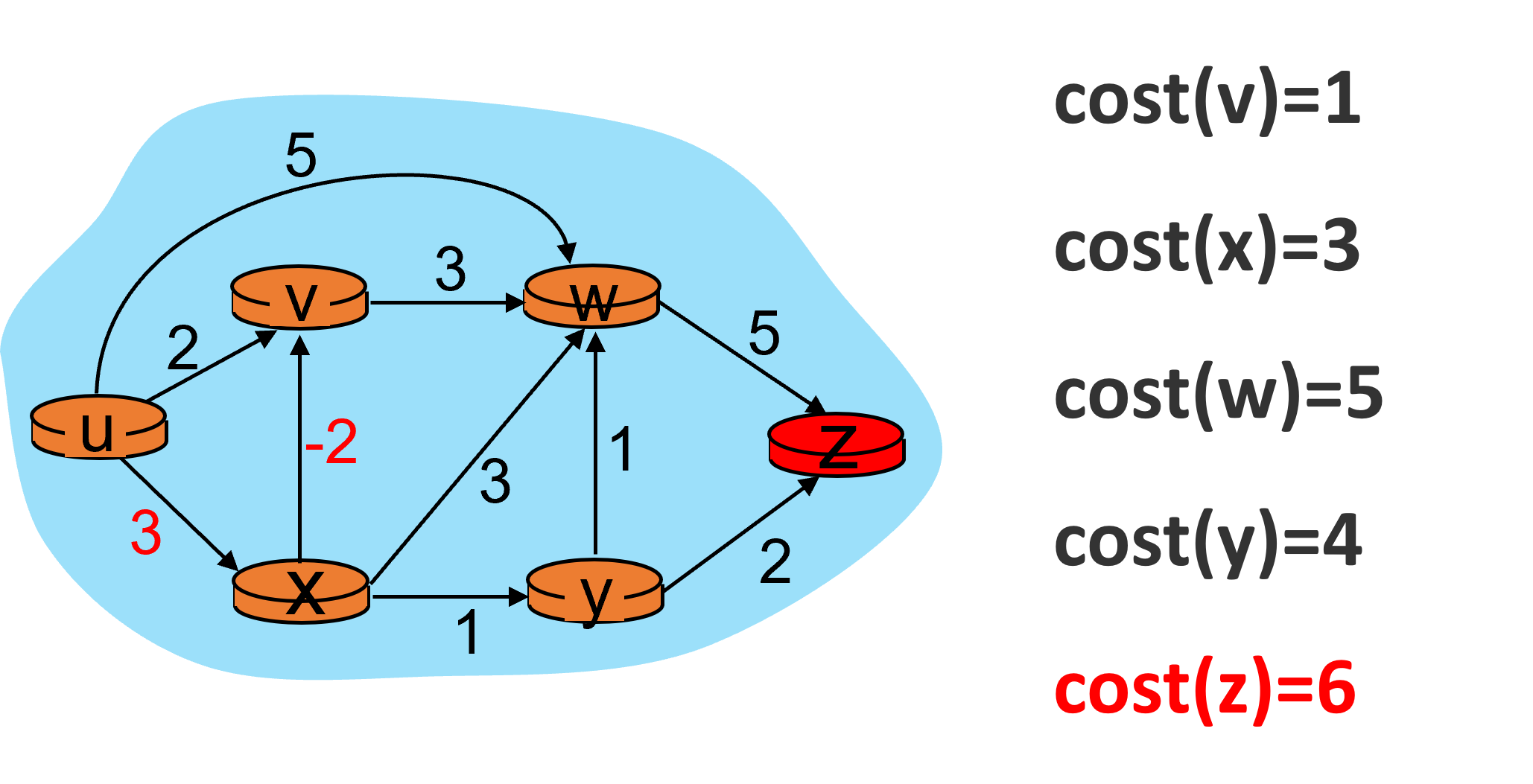
最后再处理z节点。z节点没有邻居节点。
在第一次遍历的过程中,节点v和z的开销发生了变化。这可能会引起其他节点开销的改变。于是遍历一下这两个节点。
首先是v节点,它开销的变化导致w节点的开销也变化了。
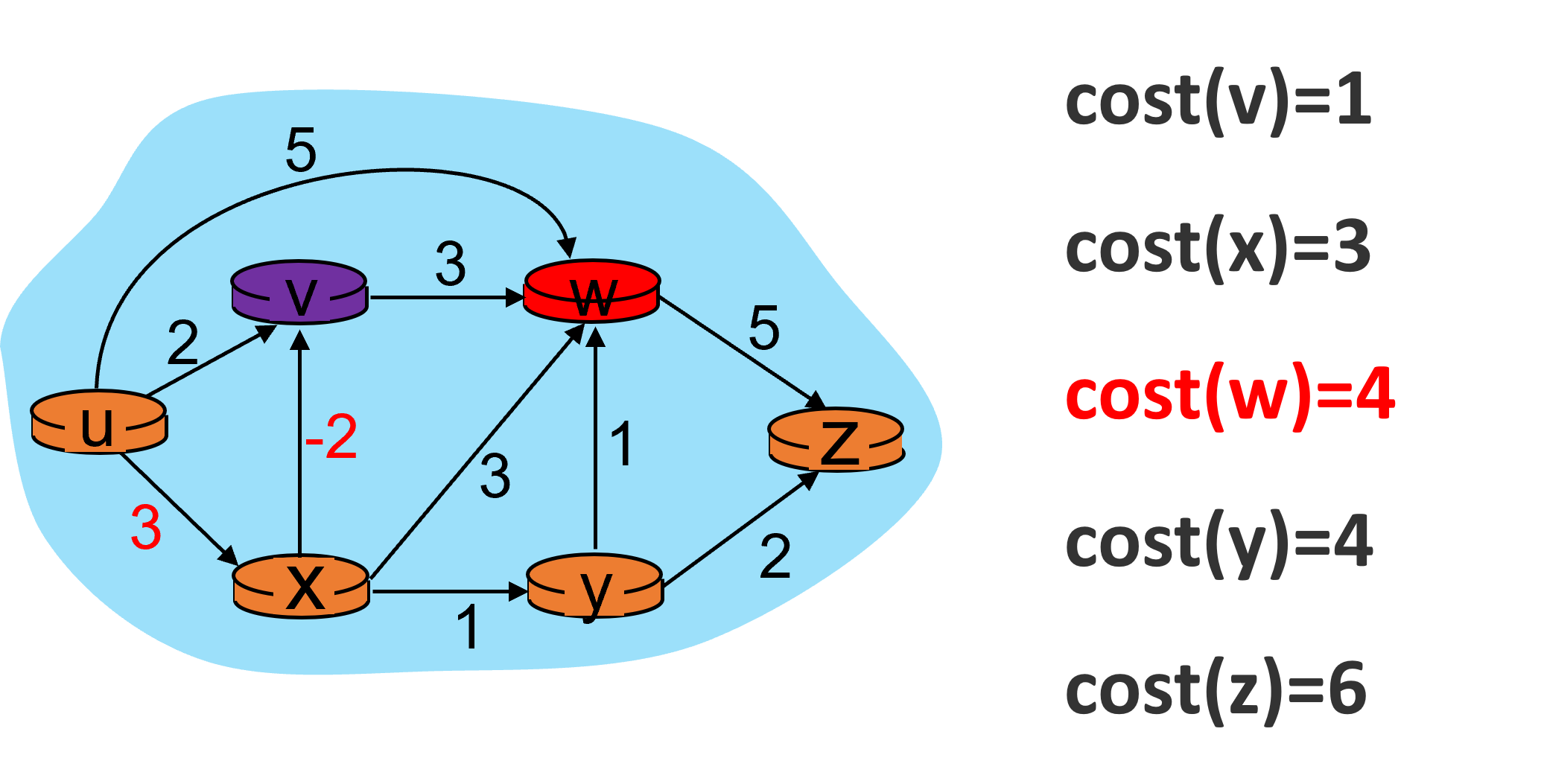
然后是z节点,但是由于它没有邻居节点,因此没有影响。第二次迭代结束。由于本次迭代中,w节点的开销发生了变化,所以需要第三次迭代。
如下图所示,在第三次迭代中,没有任何节点的开销发生变化。此时可以结束迭代了。
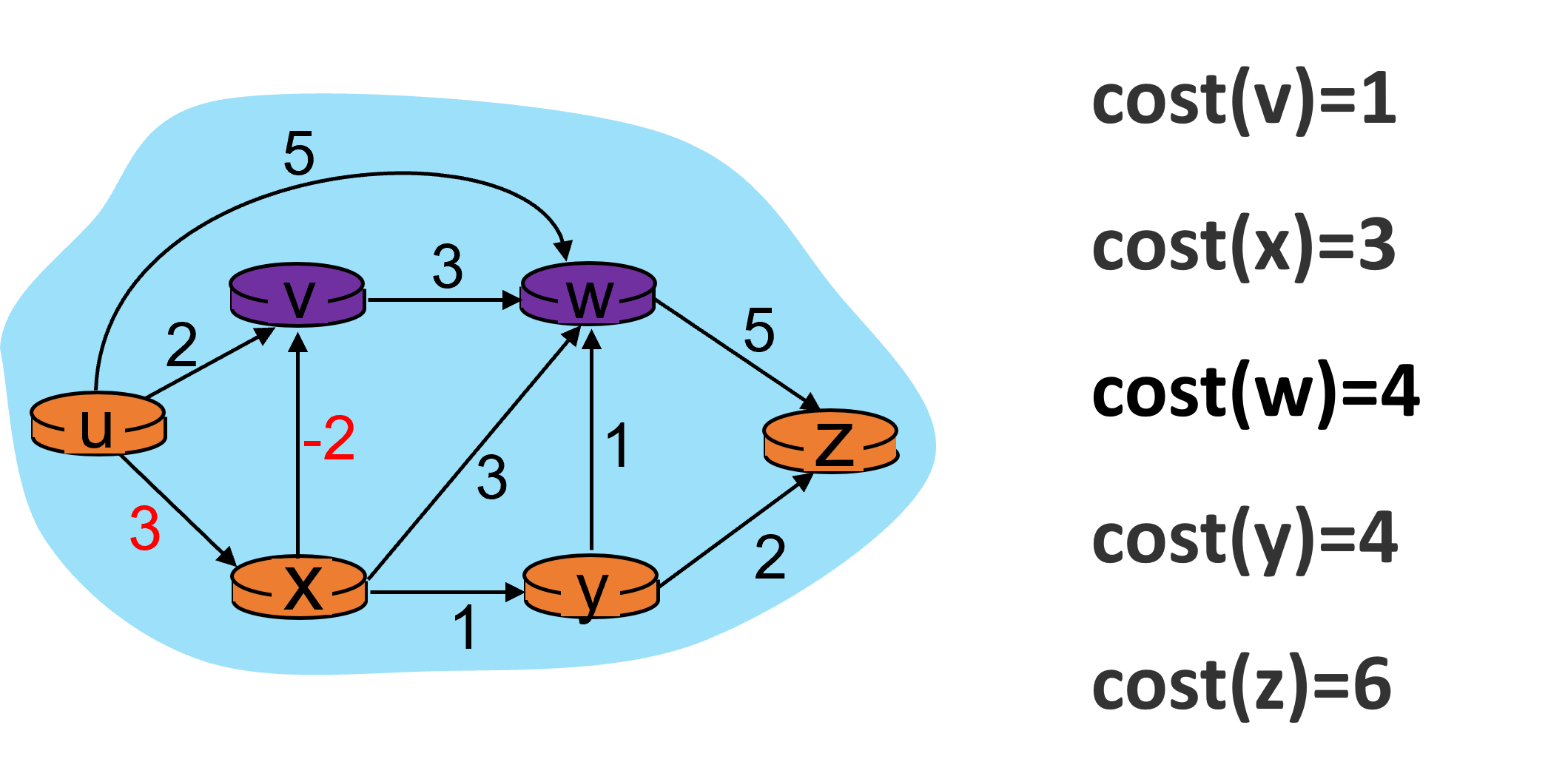
对于由V个节点组成的图,两个节点之间的最短路径,最多只能包含V-1条边。因此最多迭代V-1次就应该结束了。如果迭代次数大于V-1,就说明图中存在负权边。
看个有负权边的例子。下图中x -> v -> w和y -> w -> x构成了两个负权环。
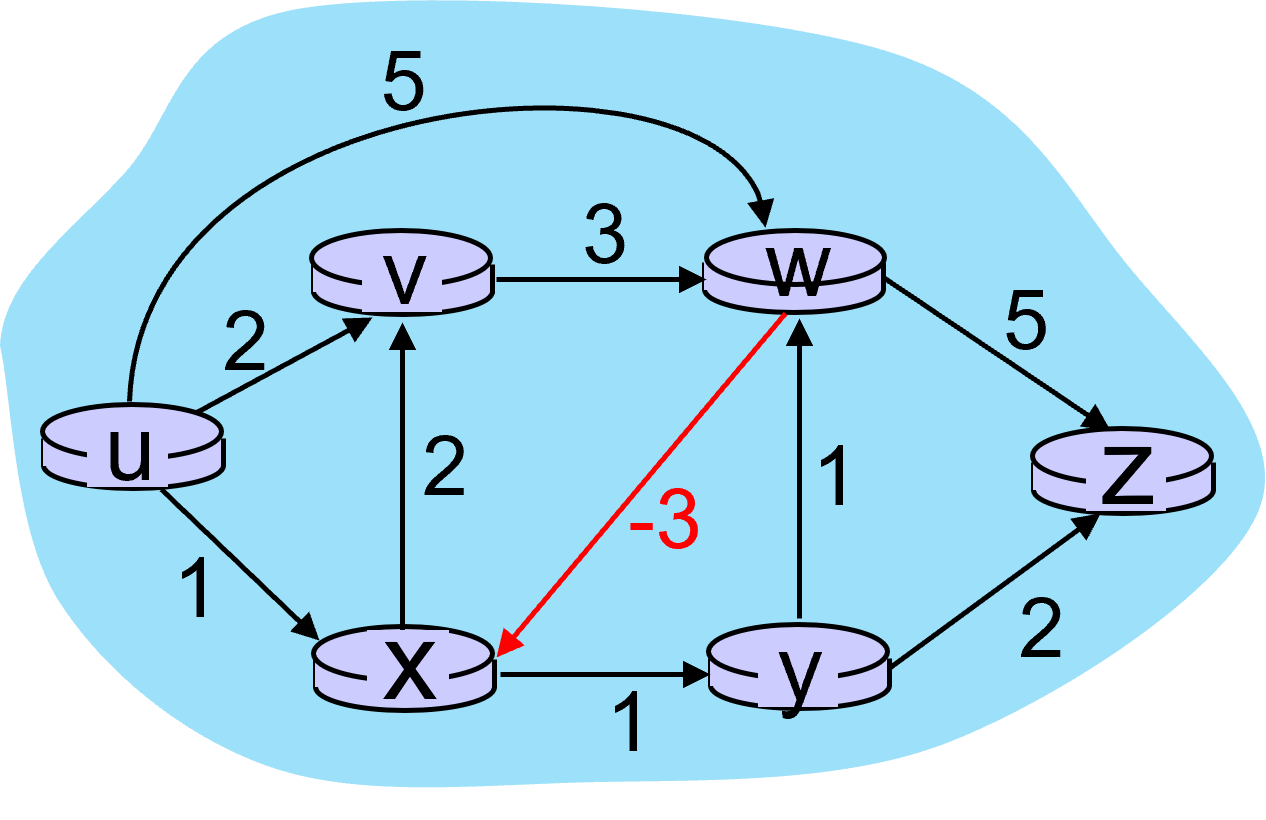
第一次迭代的过程如下图所示。
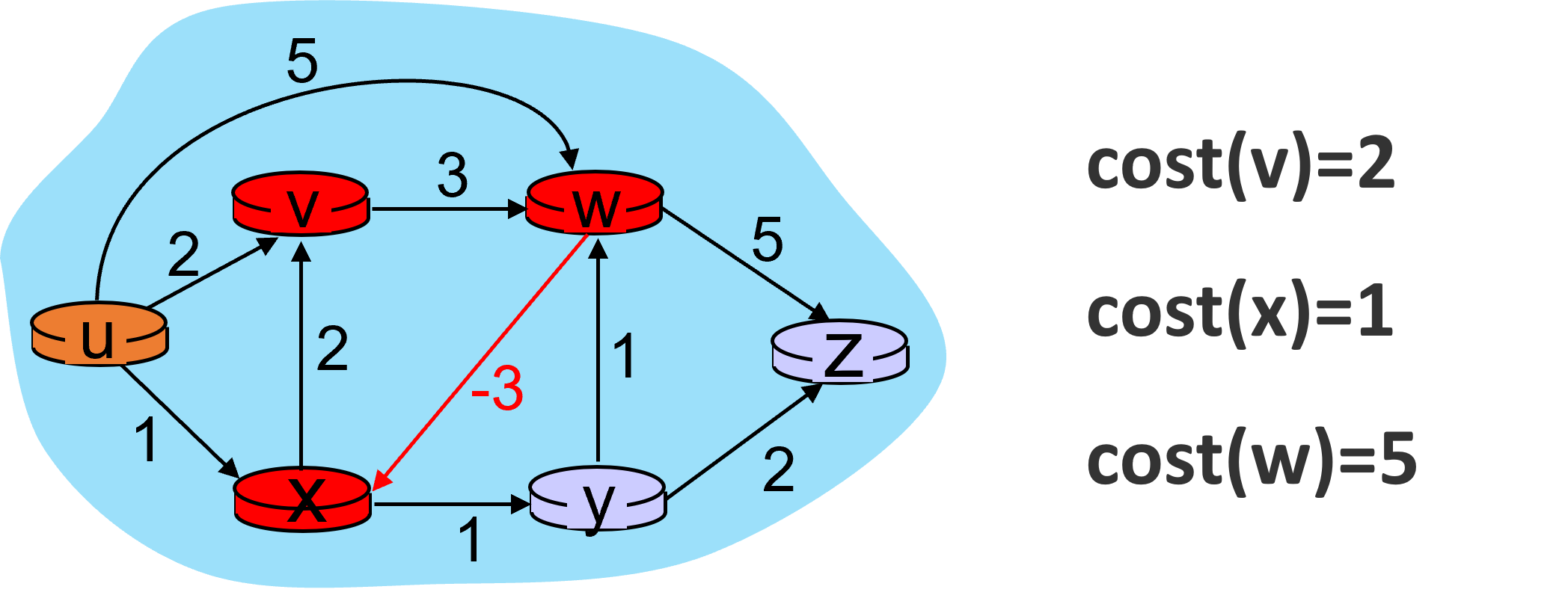
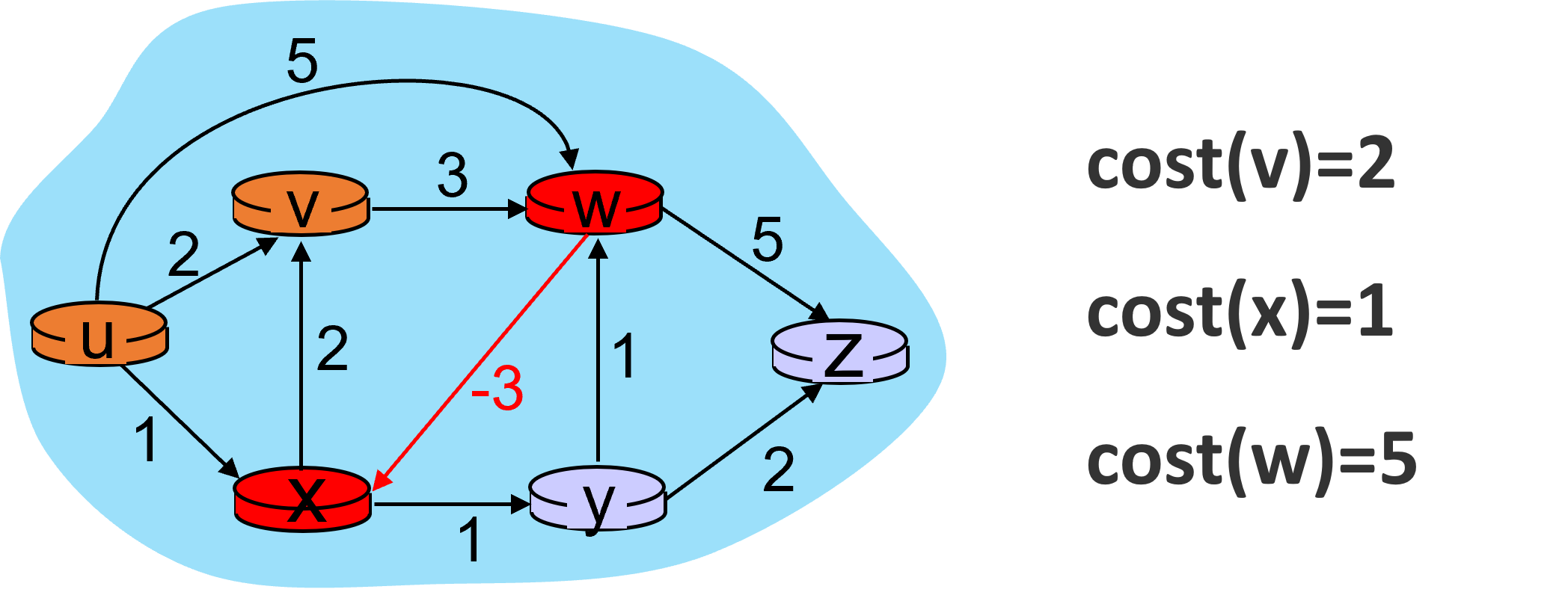
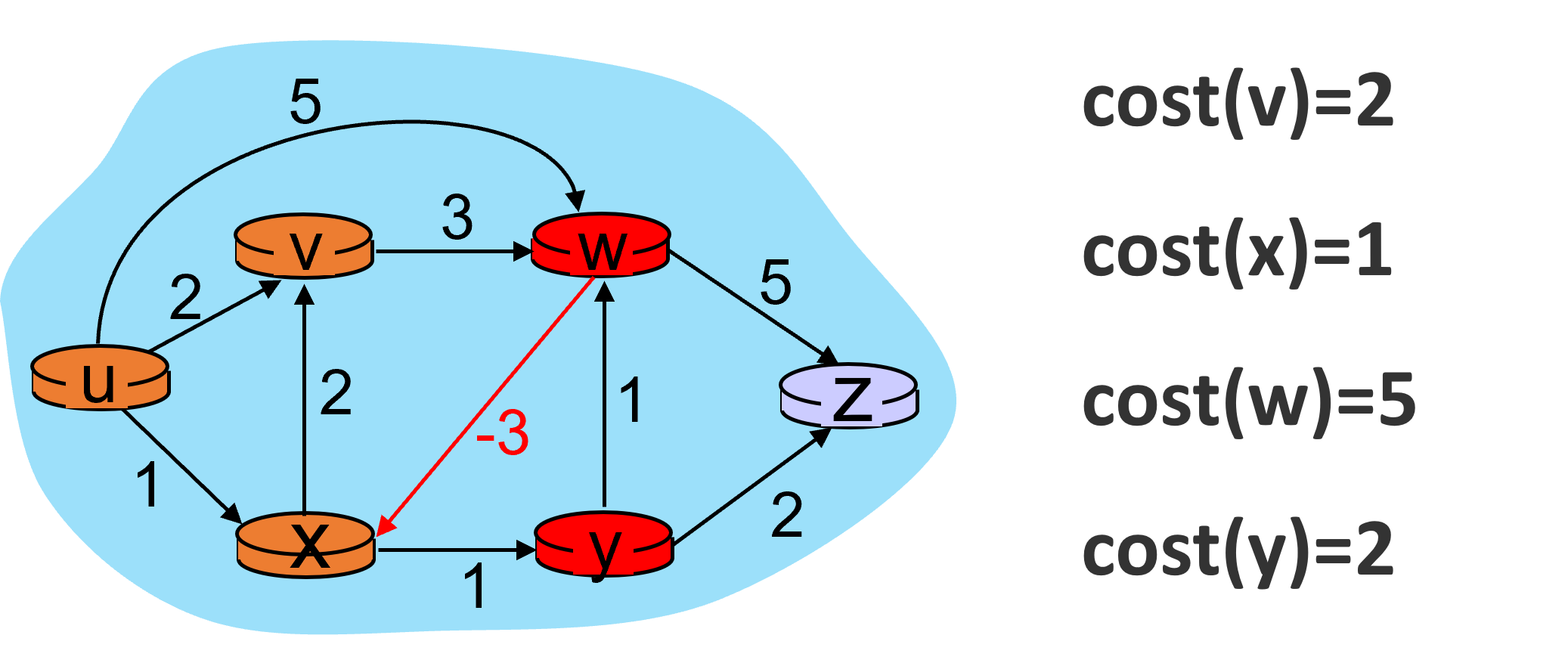
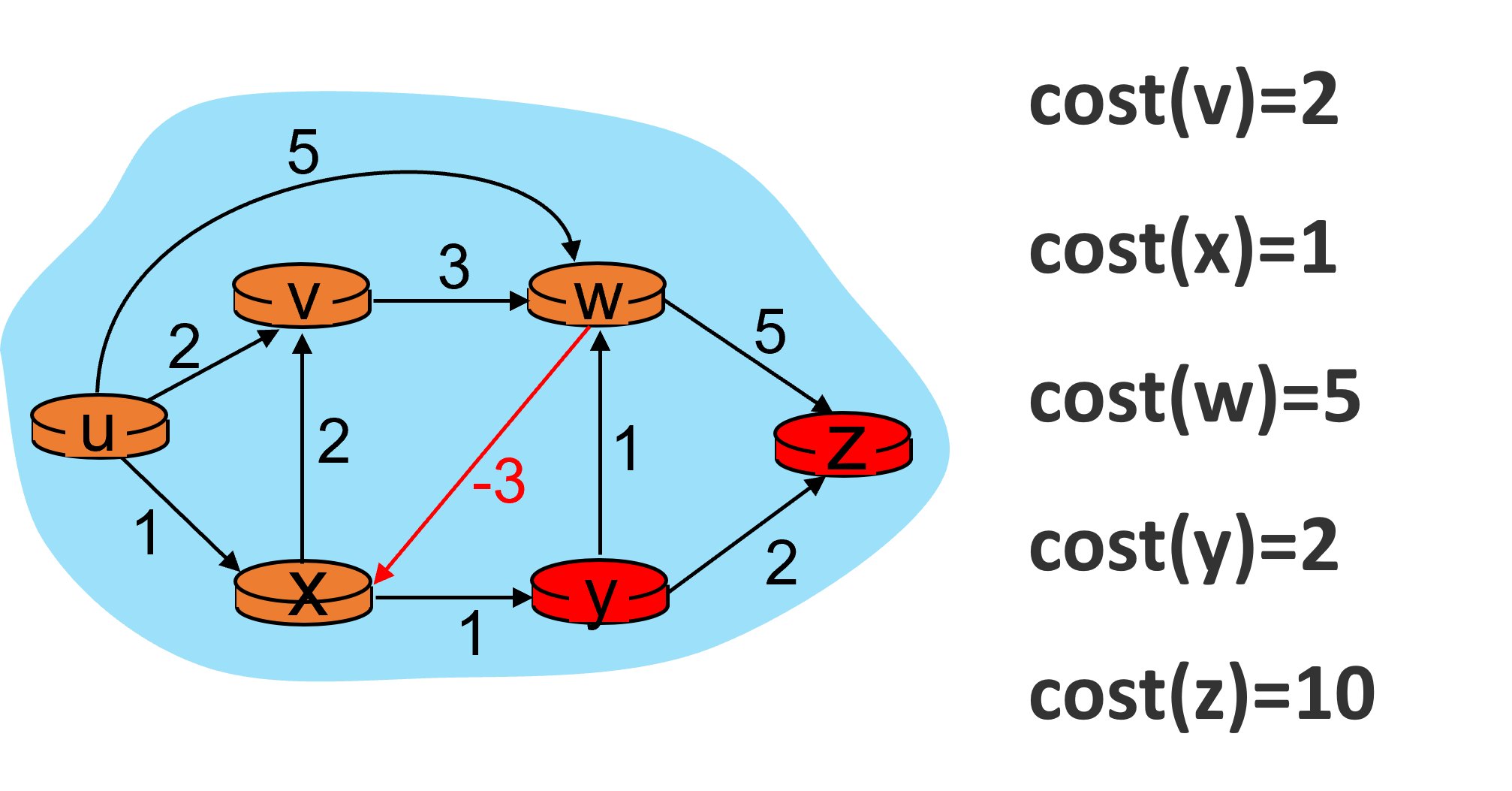
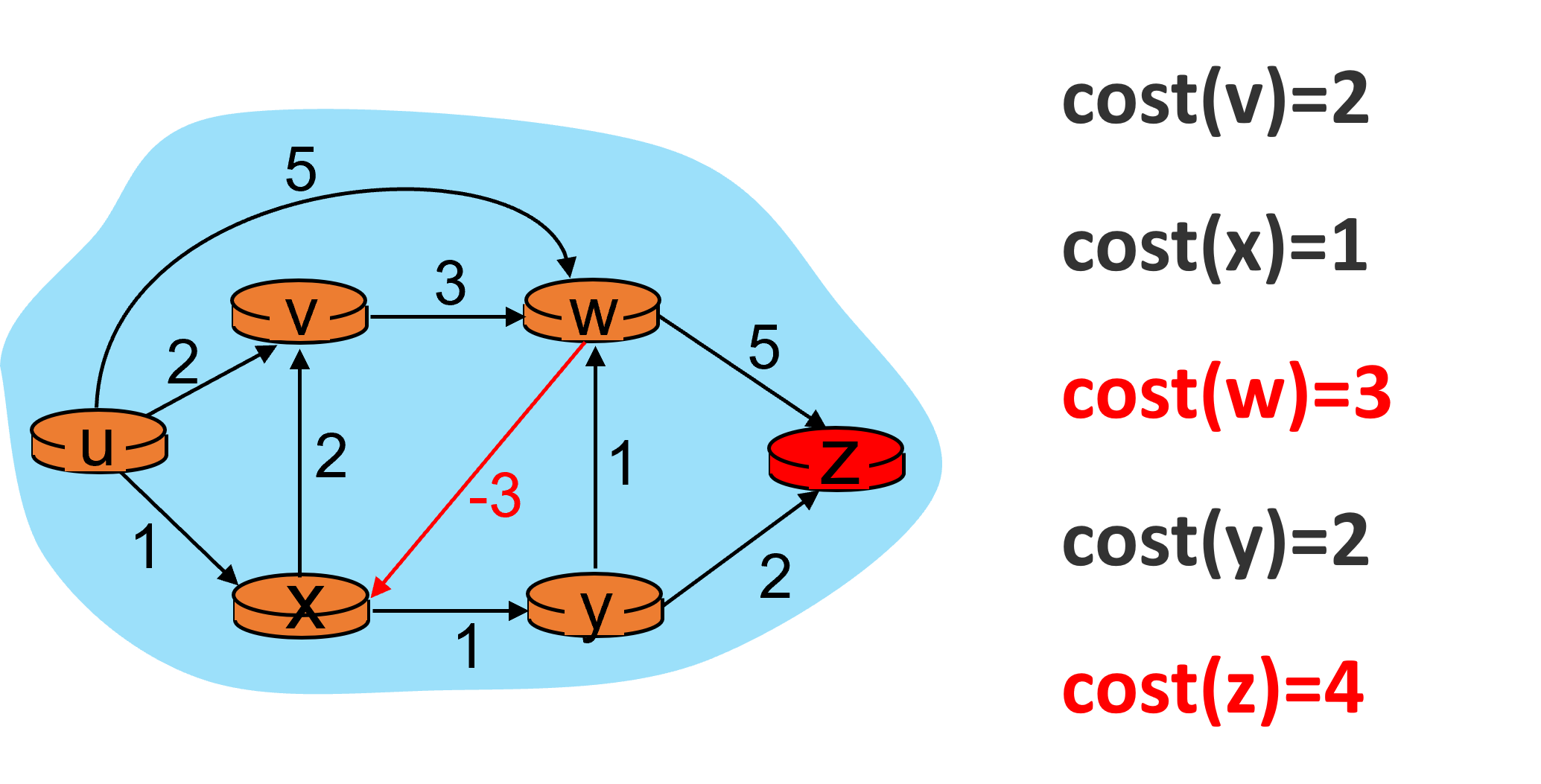
第一次迭代结束。在此过程中,w节点的开销发生了改变,于是需要第二次迭代。
此时,w节点开销的改变引起了x节点开销的变化,为0。
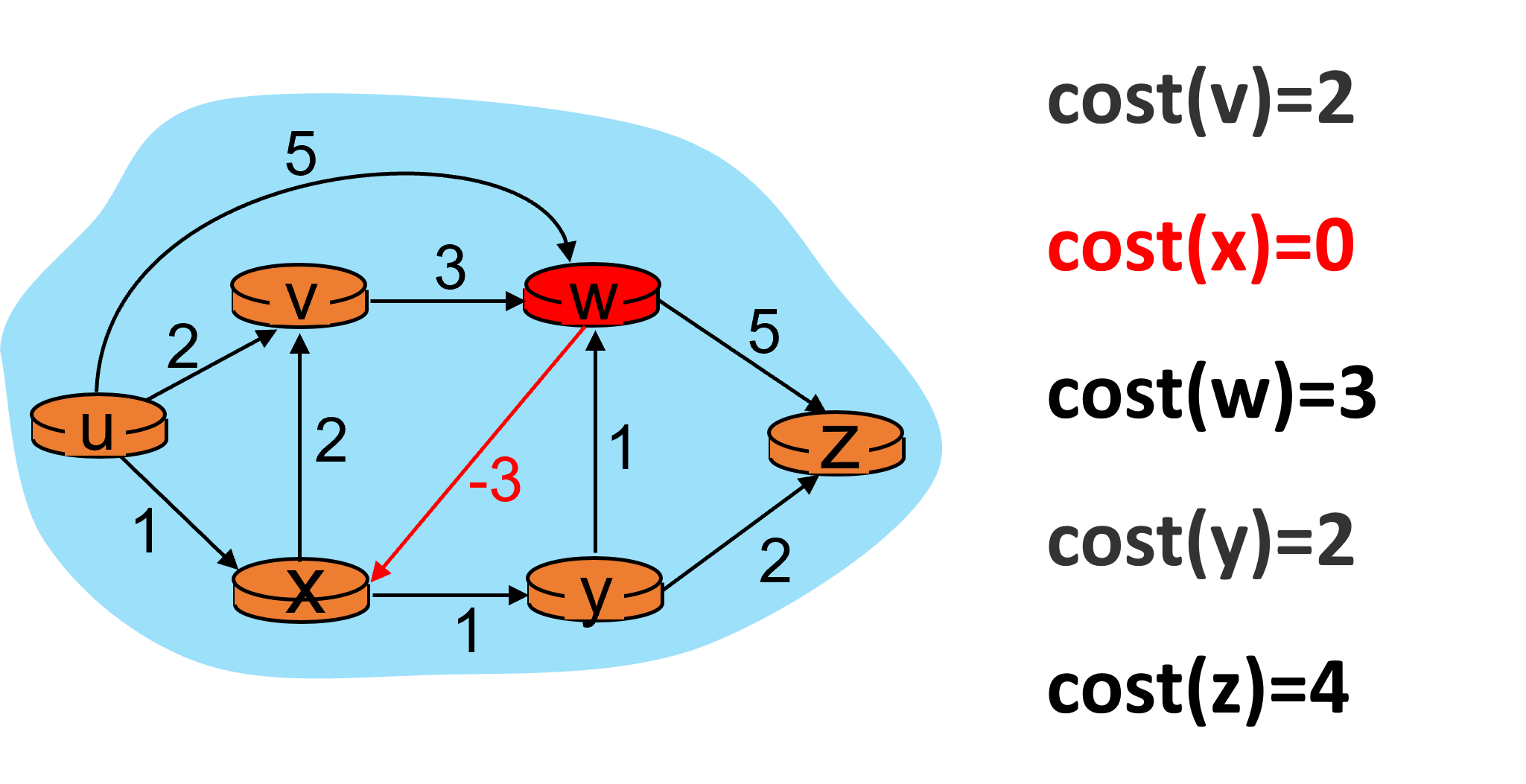
继续进入下一次迭代。x节点开销的改变引起了y节点开销的变化。
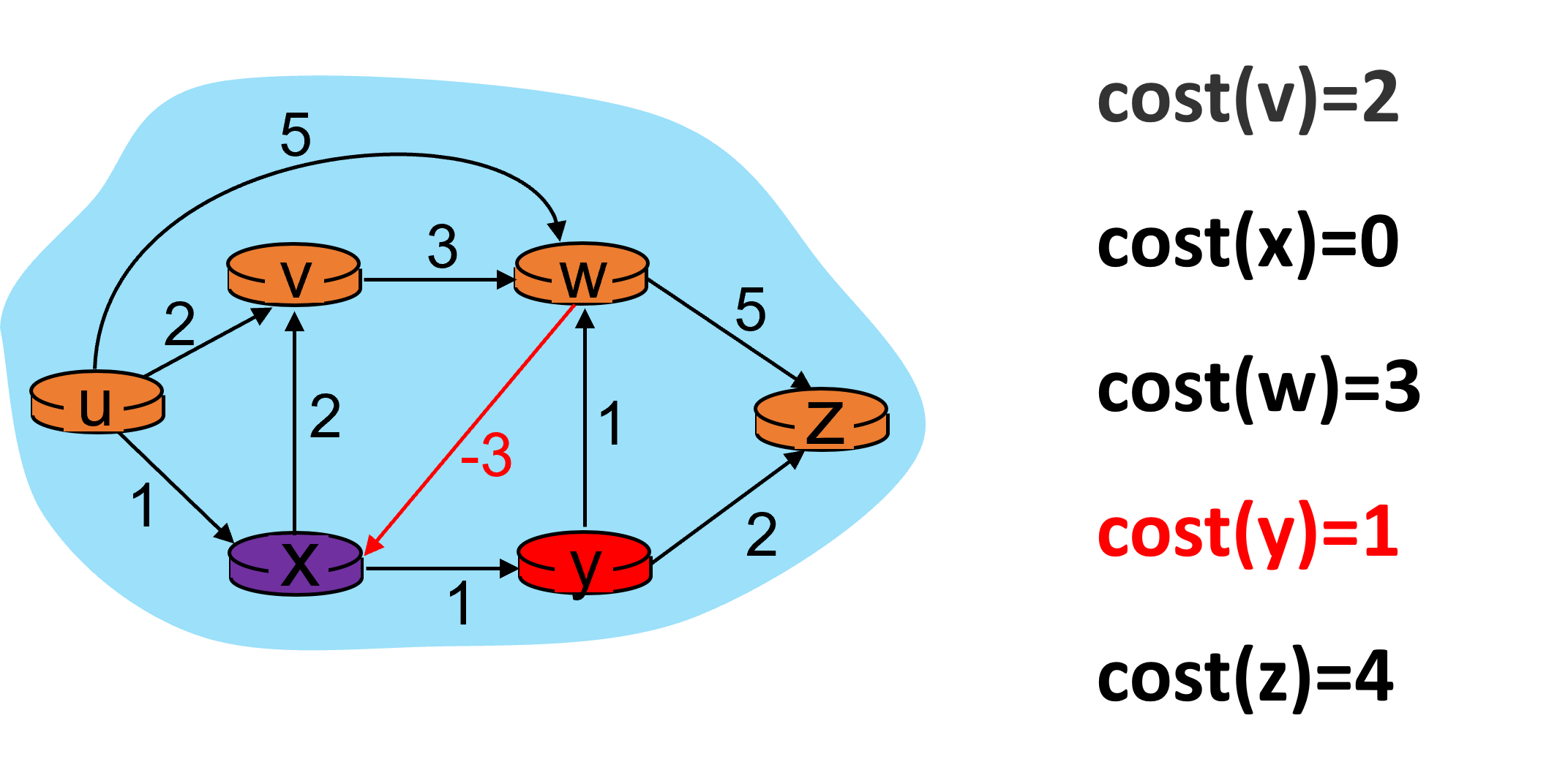
继续进入下一次迭代。y节点开销的改变引起了w和z节点开销的变化。
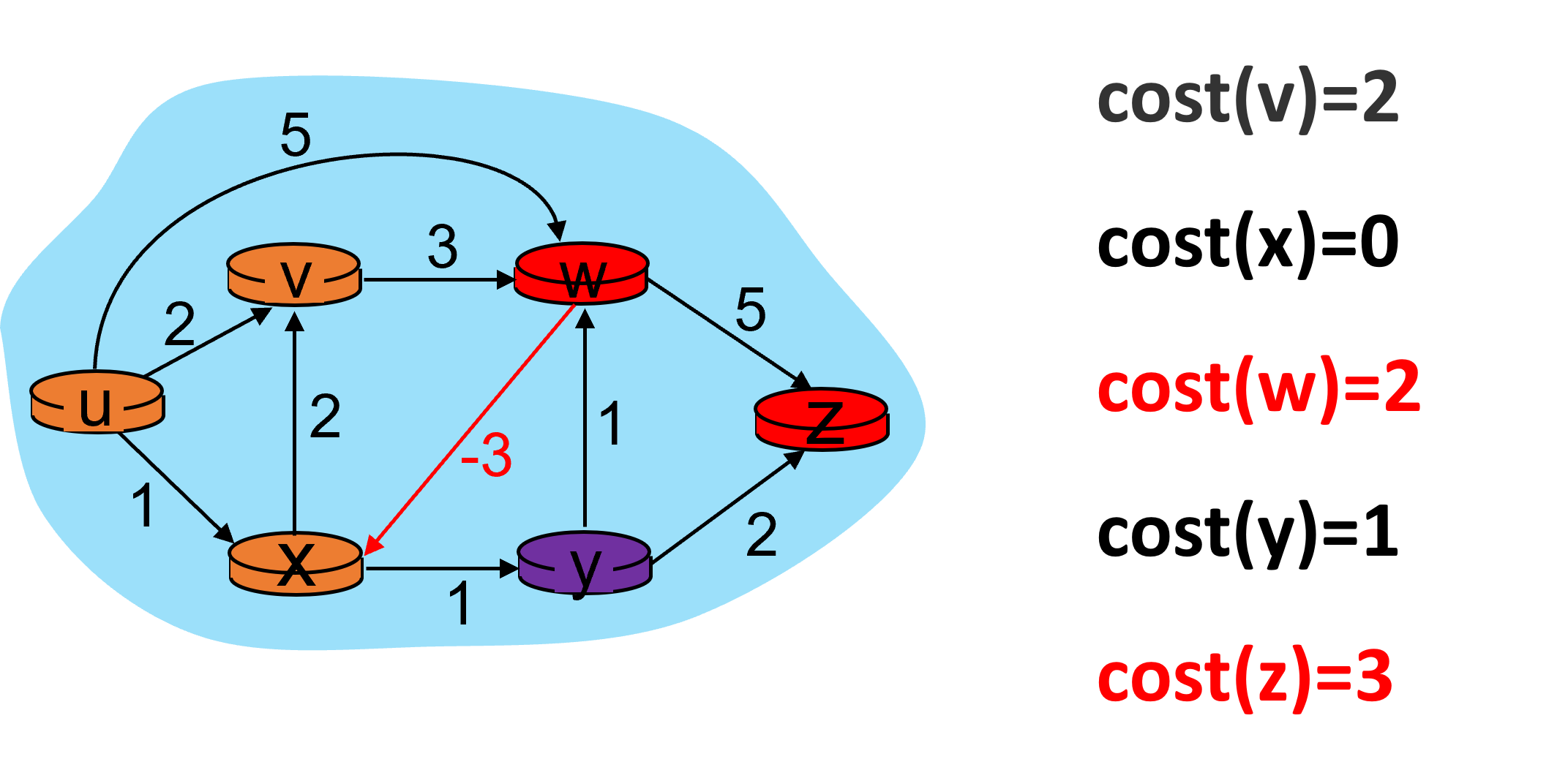
至此,已经能够发现如果存在负权环,可能会导致开销无限循环地减少的情况。Bellman-ford算法会报告负权环的存在,但不会尝试进一步计算从源点到各顶点的有效路径,因为此时的路径值不稳定。
根据GPT和其他博客所讲,Bellman-ford算法的标准化实现是在一个长度为V-1的for循环中,遍历图中的所有节点,python代码如下:
graph={} infinity=float("inf") # 为了表示出方向和权重,这里使用字典存储节点 graph['u']={} graph['u']['v']=2 graph['u']['x']=1 graph['u']['w']=5 graph['v']={} graph['v']['w']=3 graph['x']={} graph['x']['v']=2 # graph['x']['w']=3 graph['x']['y']=1 graph['w']={} graph['w']['z']=5 graph['w']['x']=-3 graph['y']={} graph['y']['w']=1 graph['y']['z']=2 graph['z']={} V=list(graph.keys()) parents={} costs={v:infinity for v in V} costs['u']=0 for i in range(len(V)-1): for node in V: cost=costs[node] neighbors=graph[node] for n in neighbors.keys(): new_cost=cost+neighbors[n] if new_cost < costs[n]: costs[n]=new_cost parents[n]=node # 检测负权环 for node in V: cost=costs[node] neighbors=graph[node] for n in neighbors.keys(): if cost+neighbors[n] < costs[n]: print("Graph contains a negative weight cycle") break print(costs) print(parents)
但是我觉得没有必要在每次迭代中,都把V中的节点全部遍历,每次只需要遍历开销发生变化的节点就可以了。所以下面的代码,我用队列存每次迭代过程中开销发生变化的节点。如果某次迭代,没有开销发生变化的节点,则终止迭代。
from collections import deque graph={} infinity=float("inf") # 为了表示出方向和权重,这里使用字典存储节点 graph['u']={} graph['u']['v']=2 graph['u']['x']=1 graph['u']['w']=5 graph['v']={} graph['v']['w']=3 graph['x']={} graph['x']['v']=2 # graph['x']['w']=3 graph['x']['y']=1 graph['w']={} graph['w']['z']=5 graph['w']['x']=-3 graph['y']={} graph['y']['w']=1 graph['y']['z']=2 graph['z']={} V=list(graph.keys()) parents={} costs={} for i in range(len(V)): costs[V[i]]=infinity costs['u']=0 nodeQueue=deque(V) tmpQueue=deque() count=len(V)-1 while nodeQueue and count: node=nodeQueue.popleft() cost=costs[node] neighbors=graph[node] for n in neighbors.keys(): new_cost=cost+neighbors[n] if new_cost < costs[n]: costs[n]=new_cost parents[n]=node tmpQueue.append(n) if not nodeQueue: nodeQueue=tmpQueue tmpQueue.clear() count-=1 for node in V: cost=costs[node] neighbors=graph[node] for n in neighbors.keys(): if cost+neighbors[n] < costs[n]: print("Graph contains a negative weight cycle") break print(costs)





 浙公网安备 33010602011771号
浙公网安备 33010602011771号